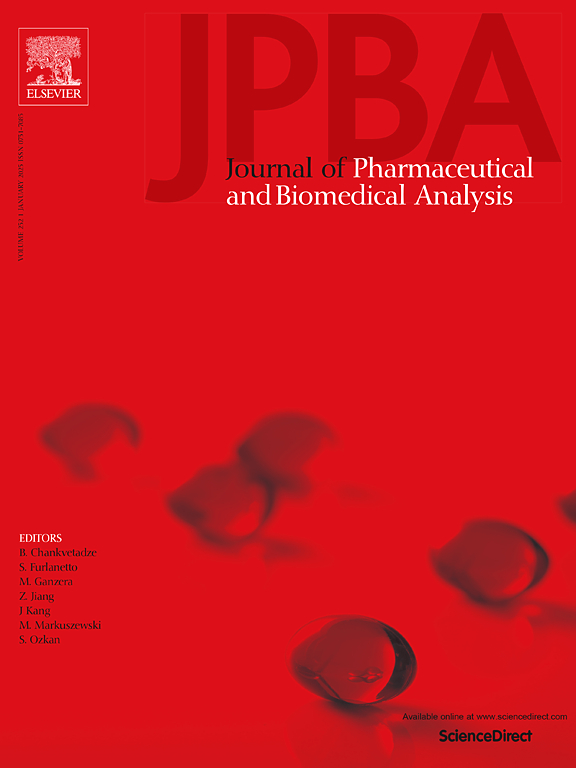Sedative-hypnotic effects of Yiyin Anshen Granule on mice models of insomnia by regulating neurotransmitters, cytokines, and gut microbiota
IF 3.1
3区 医学
Q2 CHEMISTRY, ANALYTICAL
Journal of pharmaceutical and biomedical analysis
Pub Date : 2025-05-05
DOI:10.1016/j.jpba.2025.116949
引用次数: 0
Abstract
This study aims to elucidate the pathways through which Yiyin Anshen Granule (YA) exerts sedative-hypnotic effects in a mouse model of sleep deprivation. DL-4-chlorophenylalanine(PCPA)-treated mice received intragastric administration of YA and pentobarbital sodium-induced sleep tests were conducted on days 7, 14, and 29. The levels of key neurotransmitters, cytokines and receptor protein associated with insomnia were measured using enzyme-linked immunosorbent assay (ELISA) and Western blot. Additionally, 16S ribosomal DNA (rDNA) sequencing was performed to assess the impact of YA on gut microbiota, focusing on species abundance and diversity. YA significantly shortened sleep latency (P < 0.01) and prolonged sleep duration (P < 0.01) in sleep-deprived mice, effectively improving circadian rhythm disturbances compared to the model group (MOD). Biochemical analysis revealed that YA restored abnormal neurotransmitter levels in brain tissue, increasing 5-hydroxytryptamine (5-HT), γ-aminobutyric acid (GABA), and γ-aminobutyric acid type A receptor α-1 subunit (GABAARα1) expression (P < 0.01) and reducing the glutamate (Glu)/GABA ratio (P < 0.01). Additionally, the levels of B-cell lymphoma 2 (BCL-2) and interleukin-6 (IL-6) expression were significantly decreased (P < 0.05, 0.01), while interleukin-1 beta (IL-1β) expression increased (P < 0.01). YA treatment also significantly increased gut microbiota abundance and diversity, with microbiome profiles in the YA group being closer than those of diazepam group (DZP) to the control group (CON). Notably, YA reversed the dysbiosis of high-abundance gut microbiota species associated with insomnia at both the family and genus levels (P < 0.05, 0.01). The results of the present study indicated that YA alleviates insomnia symptoms by regulating neurotransmitter and inflammatory cytokines levels, and restoring gut microbia balance. These mechanisms collectively contribute to shortening sleep latency, prolonging sleep duration, and improving sleep quality in a mouse model of insomnia.
益阴安神颗粒通过调节神经递质、细胞因子和肠道微生物群对失眠小鼠模型的镇静催眠作用
本研究旨在阐明益阴安神颗粒在睡眠剥夺小鼠模型中发挥镇静催眠作用的途径。dl -4-氯苯丙氨酸(PCPA)处理小鼠在第7、14和29天进行YA灌胃和戊巴比妥钠诱导睡眠试验。采用酶联免疫吸附试验(ELISA)和Western blot检测与失眠相关的关键神经递质、细胞因子和受体蛋白水平。此外,进行16S核糖体DNA (rDNA)测序以评估YA对肠道微生物群的影响,重点关注物种丰度和多样性。与模型组(MOD)相比,YA显著缩短了睡眠剥夺小鼠的睡眠潜伏期(P <; 0.01),延长了睡眠持续时间(P <; 0.01),有效改善了昼夜节律紊乱。生化分析显示,YA恢复脑组织异常神经递质水平,增加5-羟色胺(5-HT)、γ-氨基丁酸(GABA)和γ-氨基丁酸A型受体α-1亚基(GABAARα1)表达(P <; 0.01),降低谷氨酸(Glu)/GABA比值(P <; 0.01)。b细胞淋巴瘤2 (BCL-2)和白细胞介素-6 (IL-6)表达水平显著降低(P <; 0.05,0.01),白细胞介素-1β (IL-1β)表达升高(P <; 0.01)。YA治疗还显著增加了肠道微生物群的丰度和多样性,YA组的微生物群谱比地西泮组(DZP)更接近对照组(CON)。值得注意的是,YA在科和属水平上逆转了与失眠相关的高丰度肠道微生物群物种的生态失调(P <; 0.05,0.01)。本研究结果表明,YA通过调节神经递质和炎症细胞因子水平,恢复肠道微生物平衡来缓解失眠症状。这些机制共同有助于缩短睡眠潜伏期,延长睡眠持续时间,改善失眠小鼠模型的睡眠质量。
本文章由计算机程序翻译,如有差异,请以英文原文为准。
求助全文
约1分钟内获得全文
求助全文
来源期刊
CiteScore
6.70
自引率
5.90%
发文量
588
审稿时长
37 days
期刊介绍:
This journal is an international medium directed towards the needs of academic, clinical, government and industrial analysis by publishing original research reports and critical reviews on pharmaceutical and biomedical analysis. It covers the interdisciplinary aspects of analysis in the pharmaceutical, biomedical and clinical sciences, including developments in analytical methodology, instrumentation, computation and interpretation. Submissions on novel applications focusing on drug purity and stability studies, pharmacokinetics, therapeutic monitoring, metabolic profiling; drug-related aspects of analytical biochemistry and forensic toxicology; quality assurance in the pharmaceutical industry are also welcome.
Studies from areas of well established and poorly selective methods, such as UV-VIS spectrophotometry (including derivative and multi-wavelength measurements), basic electroanalytical (potentiometric, polarographic and voltammetric) methods, fluorimetry, flow-injection analysis, etc. are accepted for publication in exceptional cases only, if a unique and substantial advantage over presently known systems is demonstrated. The same applies to the assay of simple drug formulations by any kind of methods and the determination of drugs in biological samples based merely on spiked samples. Drug purity/stability studies should contain information on the structure elucidation of the impurities/degradants.

 求助内容:
求助内容: 应助结果提醒方式:
应助结果提醒方式:


